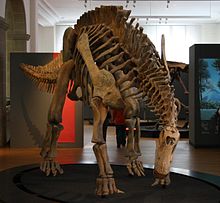| Brachytrachelopan | |
|---|---|

| |
| Restored skeleton | |
| Scientific classification | |
| Domain: | Eukaryota |
| Kingdom: | Animalia |
| Phylum: | Chordata |
| Clade: | Dinosauria |
| Clade: | Saurischia |
| Clade: | †Sauropodomorpha |
| Clade: | †Sauropoda |
| Superfamily: | †Diplodocoidea |
| Family: | †Dicraeosauridae |
| Genus: | †Brachytrachelopan Rauhut et al. 2005 |
| Species: | †B. mesai
|
| Binomial name | |
| †Brachytrachelopan mesai Rauhut et al. 2005
| |
Brachytrachelopan is a short-necked sauropod dinosaur from the Late Jurassic (Oxfordian to Tithonian) of Argentina. The holotype and only known specimen (Museo Paleontológico Egidio Feruglio MPEF-PV 1716) was collected from an erosional exposure of fluvial sandstone within the Cañadón Calcáreo Formation on a hill approximately 25 kilometres (16 mi) north-northeast of Cerro Cóndor, Chubut Province, in west-central Argentina, South America. Though very incomplete, the skeletal elements recovered were found in articulation and include eight cervical, twelve dorsal, and three sacral vertebrae, as well as proximal portions of the posterior cervical ribs and all the dorsal ribs, the distal end of the left femur, the proximal end of the left tibia, and the right ilium. Much of the specimen was probably lost to erosion many years before its discovery. The type species is Brachytrachelopan mesai. The specific name honours Daniel Mesa, a local shepherd who discovered the specimen while searching for lost sheep. The genus name translates as "short-necked Pan", Pan being the god of the shepherds.